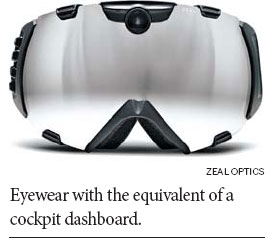High-tech goggles, with distraction risk
Updated: 2013-05-05 07:37
By Matt Richtel(The New York Times)
|
|||||||
Oakley, the eyewear company, makes a $600 ski goggle that comes with a warning in the package: Do not operate product while skiing.
It is an admonition that should be taken with a bit of skepticism, said Chris Petrillo, a product manager at the company. Of course, he said, the digital goggles are meant for skiing and snowboarding. The warning is there for legal reasons.
Safety advocates say the concept of high-tech displays for goggles - and for other sports eyewear - is information overload run amok, particularly at high speeds.
Yet Oakley, based in Foothill Ranch, California, is one of a handful of sports eyewear companies betting that thrill seekers and athletes crave the equivalent of a cockpit dashboard while skiing, cycling and running.
The companies are in the vanguard of wearable computing, which promises to further shrink the barrier between users and the data they seek. Most notably, Google is expected to introduce its computerized glasses, called Google Glass, which will perform many of the same functions as smartphones.
The goggles made by Oakley have a display in the lens that shows changing speed and altitude, and can display text messages. The goggles are equipped with global positioning technology and wireless Bluetooth. They can even show videos that are being shot in real time.
Harry Puterbaugh, 57, a farmer from Peoria, Illinois, and his wife and two daughters, 13 and 14, use high-tech goggles made by Zeal Optics of Boulder, Colorado, on ski trips. Mr. Puterbaugh likes being able to track how many runs and vertical feet he has skied, measures that he says help him push himself.
He has goggles with a built-in camera that lets him take videos. An image in the corner of the lens lets him see what is being captured, but he said he learned quickly to ignore it.
His daughters have learned to be cautious, too.

"When my girls first started using them, they would get in trouble because they were watching their speed and not paying attention to what they were doing," he said. "They would fall, but you only do that once before you realize it's not a good thing to do."
Safety advocates say it is not possible to take in simultaneously two streams of information: the real-life action, and the virtual performance data.
"You're effectively skiing blind; you're going to miss a mogul or hit somebody," said David Strayer, a neuroscientist at the University of Utah, in Salt Lake City, who studies attention and distraction. Even a glance at the information takes over a skier's field of vision and focus, he said.
Other companies are producing or developing high-tech eyewear for cyclists or runners, giving them so-called heads-up displays. Want to know your heart rate or kilometer time? Just glance inside the lens, sparing the trouble of looking down at a watch or phone app.
"Technology is opening up new dimensions in vision," said Andrew Karp, the lens and technology editor for the Jobson Optical Group, a publisher of journals for the eyewear industry. High-tech lenses "are giving images, data, more information, even sensory input about the things we're seeing," Mr. Karp said. "This trend is going to accelerate."
The International Vision Expo, a trade show in New York in March, featured Pivothead, which makes $299 sunglasses with a high-definition camera; Zeal Optics, which offers goggles with an embedded video camera; and 4iiii, a Canadian company with a device that clips to the side of any glasses. The 4iiii has an arm that extends beneath the right lens, showing LED lights visible in the bottom of the lens. The lights offer data about heart rate, cadence and speed.
Oakley, and John Sanchez, president of Zeal Optics, said they knew of no accidents. "Sure, somebody could stare at this long enough to go into a tree," said Colin Baden, Oakley's chief executive. "We don't encourage it."
The New York Times
(China Daily 05/05/2013 page11)